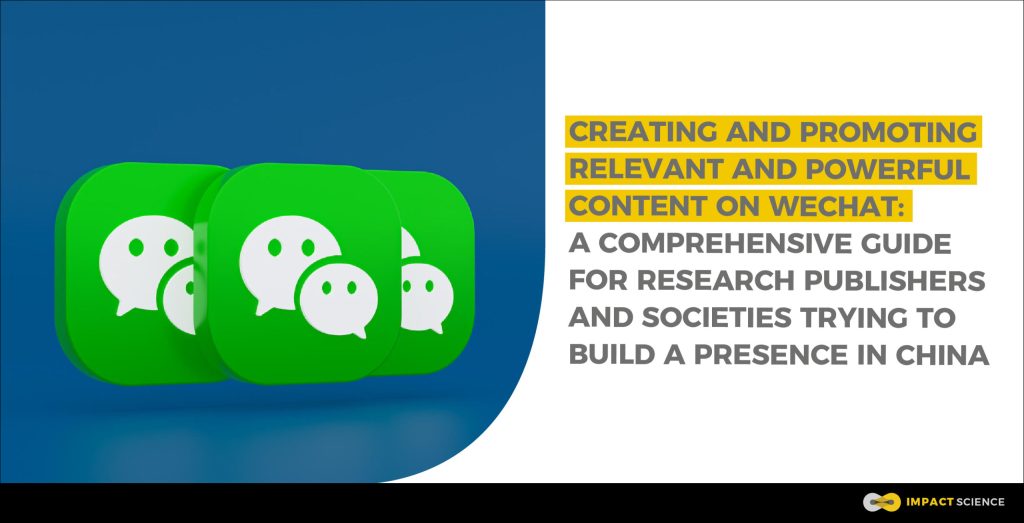As Western research publishers focus on building a presence in China, they are increasingly paying attention to Chinese social media platforms, especially WeChat. WeChat plays a critical role in the daily life of over 1.2 billion active users, including Chinese academics.
Researchers in China rely heavily on WeChat for two reasons. First, in the past 12 years, Chinese people (including academics) have gradually become habituated to using WeChat for instant communication, information acquisition and routine services, such as ordering food, taxis, and movie tickets. Chinese researchers might visit the website of a journal they are interested in occasionally, but they check WeChat almost every waking hour.
Second, WeChat articles are easy to share and view on mobile phones, for example, on a bus or subway during one’s daily commute or in the middle of a long and tedious meeting. Most Chinese academics subscribe to official WeChat accounts that share high-quality academic news and research information. In this way, they can automatically receive the latest articles and stay updated with their fields anywhere.
This article provides an overview of how to create a WeChat article, how to make it engaging, and how to attract readers to your articles and ultimately to your account.
See also: WeChat for Academia: 5 Western Publishers Who Have Created an Online Presence in China
Steps to create a WeChat article
Creating a basic WeChat article is straightforward. This section will introduce the basic steps of creating a WeChat article.
1. Log in to the WeChat official account platform, by scanning a QR code or by entering your password.


2. On the homepage of the official account platform, go to the “new creation” section in the middle of the web page. Select your content type, for example, “Article” as in the below screenshot. You can see more options on the right-hand side by clicking the “More” menu. Although most of the menu has been translated into English in the English version, some of the menus are still in Chinese.

3. On the content creation page, you can find the text edit toolbar on the top, similar to a Microsoft Word document. The system provides a default template that shows where to position the title, author, and main content. At the bottom of the page, you can choose to save your article as a draft or preview or distribute it to users by clicking the broadcast menu. The article setting menu is in the lower right corner (the red box in the below screenshot).

4. On the article setting page, you can set up a cover image and also create a short summary. You will need to confirm that the content is original (as highlighted in the screenshot), add source links (if any), enable users to send private messages to the official account, and indicate whether the article belongs to any collection.

5. Once you click on the statement of originality, you will get a pop-up window to review and confirm the statements. After ticking the check box and clicking “Next”, the system will show more settings (as the second screenshot shows). For example, you can enable the reward function to receive donations from readers. You can set the article type so that your target audience can quickly find your articles according to their interests. The last option allows you to add a whitelist for other official WeChat accounts that can republish your article.


6. Once all settings are chosen, you can publish your article. The publish button is hidden in the broadcast menu. You will need to click on the arrow beside “broadcast,” and the “publish” link will appear on top. Before publishing, you will get a confirmation page. The system will not automatically send the article to subscribers. Instead, you need to copy the URL of the published article and add it to related functions for sharing, such as the customized menu, autoreply, collection and webpage content.


7. After publishing the article, you can click on “broadcast”, and the system provides two options: timed broadcast and grouped broadcast. There are two types of official accounts: subscription and service. A subscription account can only broadcast one message every day. A service account can broadcast four messages a day.
See also: WeChat for Academia: Understanding Subscription and Service Accounts

8. If the creator of the article does not have admin permission, the system requires verification from the official account administrator. The account admin needs to scan a QR code and use their WeChat for verification. The second screenshot shows the admin view while confirming an article broadcast.



9. After the broadcast verification, the system automatically sends the article to the subscribers’ message channel.

See also: WeChat for Academia: Mini-Programs and How to Use Them
Crafting an Effective WeChat Article
Let’s take a look at what makes a WeChat article attractive and engaging for users, especially researchers.
- Language
Although most Chinese academics are able to read and understand articles in English, articles in Chinese are more popular. Some international WeChat official accounts provide multilingual content to meet personalized needs.
- Title
The article title is the first vital hook to attract the audience to read more. Usually, a good WeChat article has a short title, and all the keywords are self-explanatory.
- Novelty
The most attractive WeChat articles are usually trendy and provide valuable new knowledge and information. Novelty is one of the essential aspects of research. Therefore, articles about new research findings and funding resources are particularly popular among Chinese researchers.
- Originality
Chinese academia are becoming increasingly aware of academic integrity issues, and value originality in WeChat articles. If researchers read similar content across different WeChat articles, they will lose trust in your official account and may even cancel their subscription.
- Authenticity
Chinese researchers check whether an article contains authentic scientific information. If the article lacks scientific evidence to support the argument, Chinese researchers might doubt its authenticity and consider you a provider of superficial news articles rather than a credible source of scientific information.
- Mode
In the digital era, we are surrounded by multimedia content everywhere. An article with only lengthy text lacks appeal to a WeChat audience. WeChat articles with multimedia content, such as audio, video, gifs, and images are more popular.
- Structure and attention to detail
Chinese researchers are trained to be rigid and critical in developing and evaluating research-related content, even if it is just a WeChat article. Format, structure, logic, and language are essential for your articles to be perceived as high quality.
See also: WeChat for Academia: 3 Scientific Accounts with High Engagement
How to promote WeChat articles
Many analytics platforms provide data regarding WeChat article engagement, for example, TopSocial and Jzi.com. From their reports, you can find the most popular WeChat official accounts and articles in your field or target market for benchmarking and comparison. It is essential to know yourself and your competitors. Further, many third-party companies provide customized services that promote your WeChat articles and accounts, for example, Daizhangmen and Qianhu. However, such services have limited effectiveness if your WeChat articles themselves are low-quality or if your WeChat account is not well managed. Apart from the commercial approaches, here are some practical tips for increasing the number of article reads and account subscribers.
- Build a social network in China and invite reputed individual WeChat users (not just famous researchers) to share your WeChat articles in their personal WeChat moments and groups.
- Create attractive digital and paper-based posters with the QR code of your WeChat articles or official account, and circulate them through the Internet and in-person promotion events. Invite users to subscribe to the official account by offering small gifts.
- Insert hyperlinks to previously published relevant articles to attract readers to learn more about the topic and subscribe to the official account.
- Enable the autoreply feature so that users can type keywords and receive auto recommendations of relevant articles.
- Highlight the featured articles in the customized menu of your WeChat official account for easier access.
- Insert links to the WeChat articles on other social media platforms, such as Zhihu and Little Red Book.
- Develop a good strategy for setting article keywords for the WeChat search engine to show your articles easily.
Conclusion
The Chinese research publishing market is unique with its specific cultural background and socioeconomic-political context. WeChat is an important part of the Chinese digital ecosystem, and WeChat services play a dominant role in Chinese academics’ daily life and work. Therefore, creating reputed WeChat official accounts with a continuous flow of good-quality WeChat articles is the foundation for building trust in your brand among Chinese academia.









